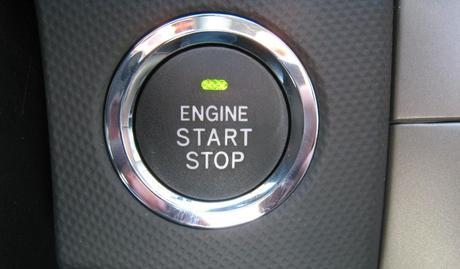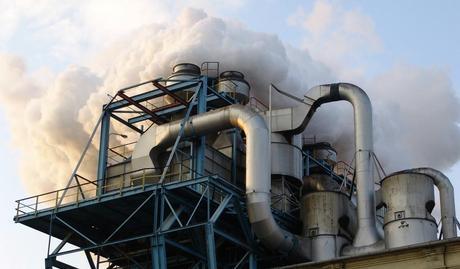 An in-ceiling air curtain at a building entrance. The device saves energy by keeping conditioned air inside the building. (Credit: Flickr @ Berner International http://www.flickr.com/photos/bernerinternational/)
An in-ceiling air curtain at a building entrance. The device saves energy by keeping conditioned air inside the building. (Credit: Flickr @ Berner International http://www.flickr.com/photos/bernerinternational/)When thinking about ways to increase energy efficiency, most people usually think about turning off lights and appliances when not in use or about replacing incandescent bulbs with fluorescent or even LED bulbs (at least that is what most Americans do according to this poll). While these things are important they are only a small part of what can be done to save energy. For example, a 2009 report on energy efficiency from the consulting firm McKinsey found that by 2020 country’s energy consumption can be reduced by roughly 23% percent of projected demand by deploying an array of efficiency measures across residential, industrial and commercial sectors.
As technology marches on, ideas on how to reduce energy consumption in different sectors of the economy seem to pop up regularly. Some of them are quite obvious like constructing the buildings in accordance with the latest energy efficiency standards or using high intensity discharge lamps for outdoor lighting applications. Other ways to increase energy efficiency we wrote about in the past few months are less well-known. As it turns out, significant energy savings can be achieved with a help of cloud computing, advanced traffic control systems or even by simply planting some trees in a right place.
Cloud Computing

Huge data centers are the backbone of the cloud computing technologies. This photo depicts some of the colocation hosting server cabinets of the SwitchNap—the world’s largest (2.2 million square feet) operating data “campus”, situated in southern Nevada. (Credit: Switch http://www.switchlv.com/)
A six-month study led by Lawrence Berkeley National Laboratory (Berkeley Lab) with financial support from Google has found that moving common software applications used by 86 million U.S. workers to the cloud could save enough energy annually to power Los Angeles for a year. According to the report which summarizes the study, moving three most common business applications, namely, email, customer relationship management software and productivity software (word processing, spreadsheets etc.) from local computers to centralized cloud services can cut information technology energy consumption by up to 87 percent or by 326 Petajoules.
While these estimates are not without uncertainties, the energy savings potential of cloud-based software is likely to be substantial on a national scale given the vast differences between the energy efficiencies of local and cloud data centers. And there are some other potential energy savings associated with cloud computing. An ongoing process of dematerialization (i.e. a reduction in demand for physical goods due to widespread adoption of digital services) is also contributing to energy savings. For example, this study shows that purchasing music digitally reduces the energy consumption and carbon dioxide (CO2) emissions associated with delivering music to customers by between 40 and 80% from the best-case physical CD delivery. The same principle applies to digital news (as opposed to print media) and some types of e-commerce.
Climate Action, a sustainable development organization, working in partnership with the United Nations Environment Program (UNEP), has recently moved its email systems to a renewable-powered data center in Iceland specifically for that reason. “As an organization that has worked in partnership with the United Nations Environment Program (UNEP) for the last six years, and advocated the need for greater sustainability within international business, it is important that we ensure our own activities are as green as they can be,” said Adam Nethersole, Director at Climate Action.
Advanced Road Traffic Control

The start-stop engine technology is one of the most popular fuel saving features in modern cars. (Credit: Flickr @ Titanas http://www.flickr.com/photos/titanas/)
Hybrid or fully electric cars could one day replace the cars with internal combustion engines, especially with the development of advanced battery technologies. Also, chances are, that hydrogen production methods will become cheap enough to make “hydrogen economy” a reality. But while we are waiting for those things to happen, it is possible to save quite a lot of energy and cut carbon dioxide emissions by optimizing the kind of road traffic we have now.
A recent pilot project, conducted by the Technical University of Munich (TUM), BMW Group, TRANSVER GmbH and the Supreme Building Authority in the Bavarian Ministry of the Interior, in two test beds in the north of Munich (Germany), has shown that it is possible to cut journey times and fuel consumption by 20% by introducing improved traffic signal control and driver information systems.
Although the test route was only three miles long, the intelligent traffic light control scheme was able to reduce the travel time by about a minute. The best results were achieved by a dynamic model which can respond to traffic conditions. A decreased number of stops at signalized intersections allowed to reduce the mean waiting time from about one minute to seven seconds. An optimized fixed-time control system wasn’t as good, but it still was able to half the waiting period. The intelligent control system increased the share of intersections that can be passed without stops from about 60 percent to almost 100 percent.
Another way to increase energy efficiency in automobiles is to reduce the number of unnecessary stops for inspection purposes. For example, in many countries there are regulations in place to prevent trailer owners from overloading their vehicles. In order to check if the vehicle has been loaded according to regulations, one obviously needs to stop it. After the inspection, when a vehicle accelerates to normal speed, it wastes a lot of fuel for no good reason. A research project currently underway in Norway is testing advanced sensors installed in the road surface in combination with number plate recognition systems to detect incorrectly loaded trailers without stopping them.
Waste Heat Recovery

Waste heat emanating from an industry plant (Credit: Flickr @ Stefan Gara http://www.flickr.com/photos/gara/)
Only a fraction of the total energy we produce is actually used for its intended purpose; the majority of the energy is wasted as useless heat. The need for functioning systems to reject heat is fundamental to the laws of thermodynamics. In energy generation, by-product heat can sometimes be put to use as hot water or steam for district heating.
For example, the New York City steam system, the world’s largest system of this kind, carries the steam under the streets of Manhattan to heat, cool, or supply power to high rise buildings and businesses. According to the U.S. Department of Energy’s report, in some cases, such as industrial furnaces, efficiency improvements resulting from waste heat recovery can improve energy efficiency by 10% to as much as 50%. On a smaller scale, however, waste heat recovery presents a challenge as this process usually requires high initial temperatures.
One approach to recovering wasted heat energy is to use a thermoelectric generator, a device that converts heat (temperature differences) directly into electrical energy. The problem with these devices is that they are usually quite costly to produce and have lower efficiency than mechanical generators. Several months ago, a group of German scientists presented a new manufacturing process to solve these problems. The idea is to print thermoelectric generators cost-effectively, on a large scale and from flexible materials.
The new printing technology works similarly to an inkjet printer. The difference is that instead of a thin jet of ink, a thermoelectrically active polymer paste emerges from the cartridge and produces the around 20 to 30 micrometer thick thermoelectric sheets. When the hot steam activates the electrons in the sheet, the negatively charged particles migrate to the cooler side and an electrical voltage is produced. Even small temperature differences such as one degree Celsius are sufficient for this effect to occur.
The start-up OsmoBlue, based at the Swiss Federal Institute of Technology in Lausanne, developed another process—based on the principle of osmosis—to convert heat over 30 degrees Celsius into electricity.
Osmosis is a natural phenomenon that occurs when the concentration between two solutions separated by a membrane differs, for example between saltwater and freshwater. A stream flows from the less concentrated to the more concentrated solution, which tends to balance the concentrations on each side of the membrane. The mechanical energy of this stream may be converted into electrical energy by a turbine and an alternator. Heat is again used to separate the fluid into two separate solutions, one of which is more concentrated than the other.
As it is stated on their website, OsmoBlue overcomes the current limitations of the process described above using innovative solutions and materials. Digital modeling showed that with the OsmoBlue technology megawatts of heat could produce between 100 and 600 kilowatts of electricity.

